S plc: Capital Investment Appraisal and Financial Analysis Report
VerifiedAdded on 2023/06/18
|17
|3555
|252
Report
AI Summary
This business report focuses on the capital investment appraisal process for S plc, analyzing a potential new computer line investment. It includes a cash flow analysis statement, payback period calculation, and net present value (NPV) determination to assess the investment's viability. The report also explores the logic behind the NPV approach and its relationship with the cost of capital, along with calculating the internal rate of return (IRR). Furthermore, it contrasts bank loans with equity issues for long-term financing, calculates break-even sales revenue, and examines the margin of safety. Finally, the report distinguishes between different supplier categories and compares single versus multiple sourcing strategies in procurement.

Business Report
Paraphrase This Document
Need a fresh take? Get an instant paraphrase of this document with our AI Paraphraser

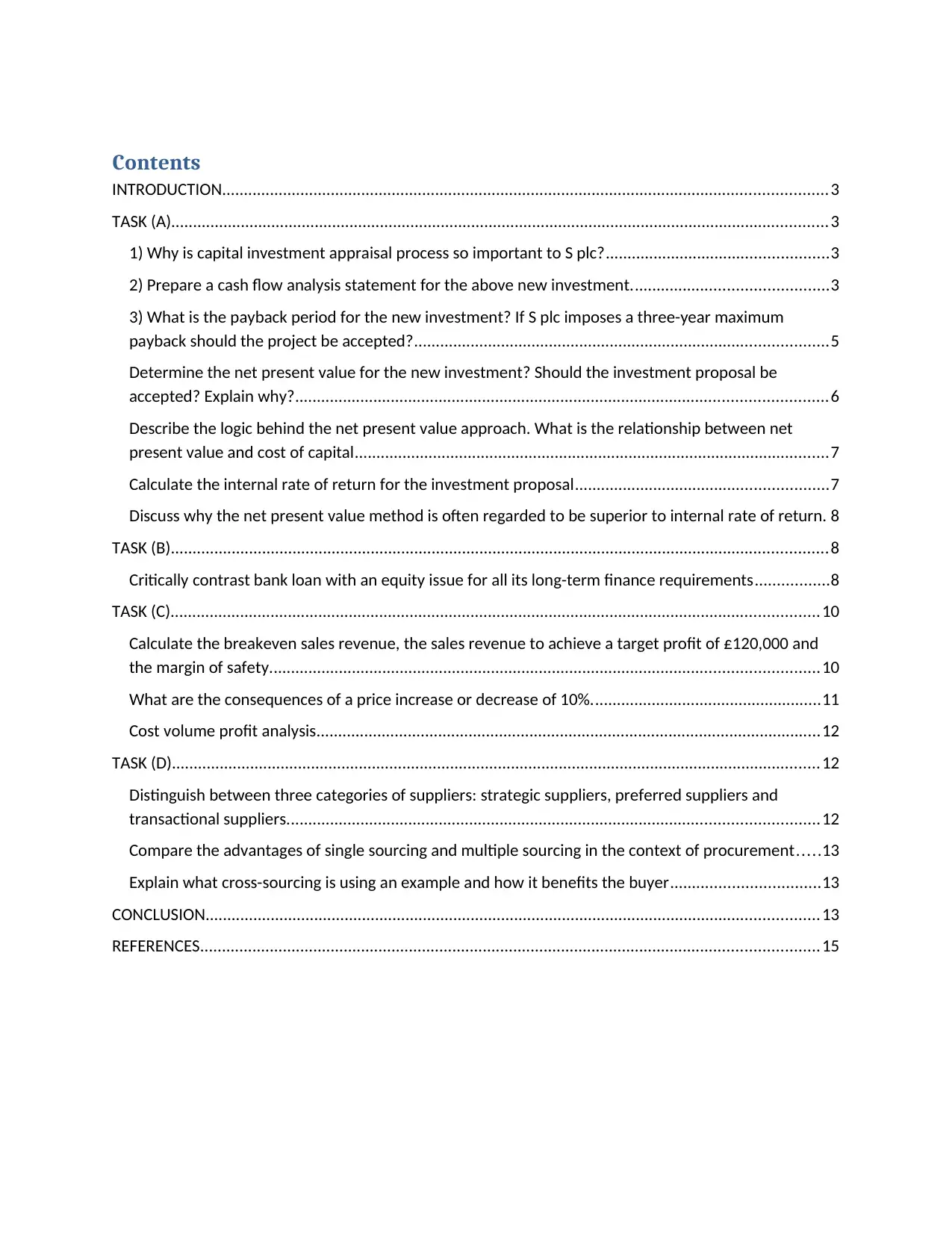
Contents
INTRODUCTION...........................................................................................................................................3
TASK (A).......................................................................................................................................................3
1) Why is capital investment appraisal process so important to S plc?...................................................3
2) Prepare a cash flow analysis statement for the above new investment.............................................3
3) What is the payback period for the new investment? If S plc imposes a three-year maximum
payback should the project be accepted?...............................................................................................5
Determine the net present value for the new investment? Should the investment proposal be
accepted? Explain why?..........................................................................................................................6
Describe the logic behind the net present value approach. What is the relationship between net
present value and cost of capital.............................................................................................................7
Calculate the internal rate of return for the investment proposal..........................................................7
Discuss why the net present value method is often regarded to be superior to internal rate of return. 8
TASK (B).......................................................................................................................................................8
Critically contrast bank loan with an equity issue for all its long-term finance requirements.................8
TASK (C).....................................................................................................................................................10
Calculate the breakeven sales revenue, the sales revenue to achieve a target profit of £120,000 and
the margin of safety..............................................................................................................................10
What are the consequences of a price increase or decrease of 10%.....................................................11
Cost volume profit analysis....................................................................................................................12
TASK (D).....................................................................................................................................................12
Distinguish between three categories of suppliers: strategic suppliers, preferred suppliers and
transactional suppliers..........................................................................................................................12
Compare the advantages of single sourcing and multiple sourcing in the context of procurement.....13
Explain what cross-sourcing is using an example and how it benefits the buyer..................................13
CONCLUSION.............................................................................................................................................13
REFERENCES..............................................................................................................................................15
INTRODUCTION...........................................................................................................................................3
TASK (A).......................................................................................................................................................3
1) Why is capital investment appraisal process so important to S plc?...................................................3
2) Prepare a cash flow analysis statement for the above new investment.............................................3
3) What is the payback period for the new investment? If S plc imposes a three-year maximum
payback should the project be accepted?...............................................................................................5
Determine the net present value for the new investment? Should the investment proposal be
accepted? Explain why?..........................................................................................................................6
Describe the logic behind the net present value approach. What is the relationship between net
present value and cost of capital.............................................................................................................7
Calculate the internal rate of return for the investment proposal..........................................................7
Discuss why the net present value method is often regarded to be superior to internal rate of return. 8
TASK (B).......................................................................................................................................................8
Critically contrast bank loan with an equity issue for all its long-term finance requirements.................8
TASK (C).....................................................................................................................................................10
Calculate the breakeven sales revenue, the sales revenue to achieve a target profit of £120,000 and
the margin of safety..............................................................................................................................10
What are the consequences of a price increase or decrease of 10%.....................................................11
Cost volume profit analysis....................................................................................................................12
TASK (D).....................................................................................................................................................12
Distinguish between three categories of suppliers: strategic suppliers, preferred suppliers and
transactional suppliers..........................................................................................................................12
Compare the advantages of single sourcing and multiple sourcing in the context of procurement.....13
Explain what cross-sourcing is using an example and how it benefits the buyer..................................13
CONCLUSION.............................................................................................................................................13
REFERENCES..............................................................................................................................................15
⊘ This is a preview!⊘
Do you want full access?
Subscribe today to unlock all pages.

Trusted by 1+ million students worldwide
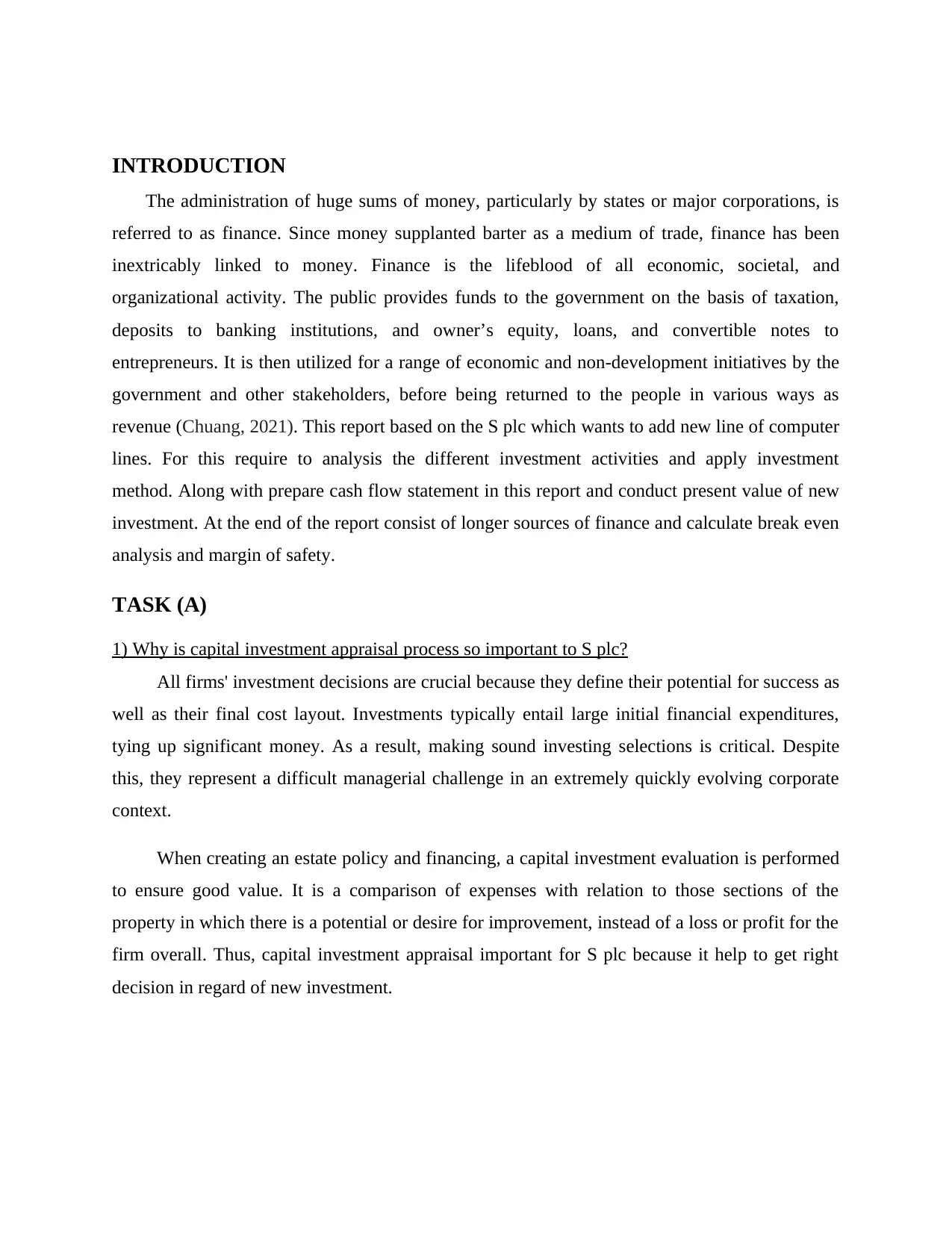
INTRODUCTION
The administration of huge sums of money, particularly by states or major corporations, is
referred to as finance. Since money supplanted barter as a medium of trade, finance has been
inextricably linked to money. Finance is the lifeblood of all economic, societal, and
organizational activity. The public provides funds to the government on the basis of taxation,
deposits to banking institutions, and owner’s equity, loans, and convertible notes to
entrepreneurs. It is then utilized for a range of economic and non-development initiatives by the
government and other stakeholders, before being returned to the people in various ways as
revenue (Chuang, 2021). This report based on the S plc which wants to add new line of computer
lines. For this require to analysis the different investment activities and apply investment
method. Along with prepare cash flow statement in this report and conduct present value of new
investment. At the end of the report consist of longer sources of finance and calculate break even
analysis and margin of safety.
TASK (A)
1) Why is capital investment appraisal process so important to S plc?
All firms' investment decisions are crucial because they define their potential for success as
well as their final cost layout. Investments typically entail large initial financial expenditures,
tying up significant money. As a result, making sound investing selections is critical. Despite
this, they represent a difficult managerial challenge in an extremely quickly evolving corporate
context.
When creating an estate policy and financing, a capital investment evaluation is performed
to ensure good value. It is a comparison of expenses with relation to those sections of the
property in which there is a potential or desire for improvement, instead of a loss or profit for the
firm overall. Thus, capital investment appraisal important for S plc because it help to get right
decision in regard of new investment.
The administration of huge sums of money, particularly by states or major corporations, is
referred to as finance. Since money supplanted barter as a medium of trade, finance has been
inextricably linked to money. Finance is the lifeblood of all economic, societal, and
organizational activity. The public provides funds to the government on the basis of taxation,
deposits to banking institutions, and owner’s equity, loans, and convertible notes to
entrepreneurs. It is then utilized for a range of economic and non-development initiatives by the
government and other stakeholders, before being returned to the people in various ways as
revenue (Chuang, 2021). This report based on the S plc which wants to add new line of computer
lines. For this require to analysis the different investment activities and apply investment
method. Along with prepare cash flow statement in this report and conduct present value of new
investment. At the end of the report consist of longer sources of finance and calculate break even
analysis and margin of safety.
TASK (A)
1) Why is capital investment appraisal process so important to S plc?
All firms' investment decisions are crucial because they define their potential for success as
well as their final cost layout. Investments typically entail large initial financial expenditures,
tying up significant money. As a result, making sound investing selections is critical. Despite
this, they represent a difficult managerial challenge in an extremely quickly evolving corporate
context.
When creating an estate policy and financing, a capital investment evaluation is performed
to ensure good value. It is a comparison of expenses with relation to those sections of the
property in which there is a potential or desire for improvement, instead of a loss or profit for the
firm overall. Thus, capital investment appraisal important for S plc because it help to get right
decision in regard of new investment.
Paraphrase This Document
Need a fresh take? Get an instant paraphrase of this document with our AI Paraphraser
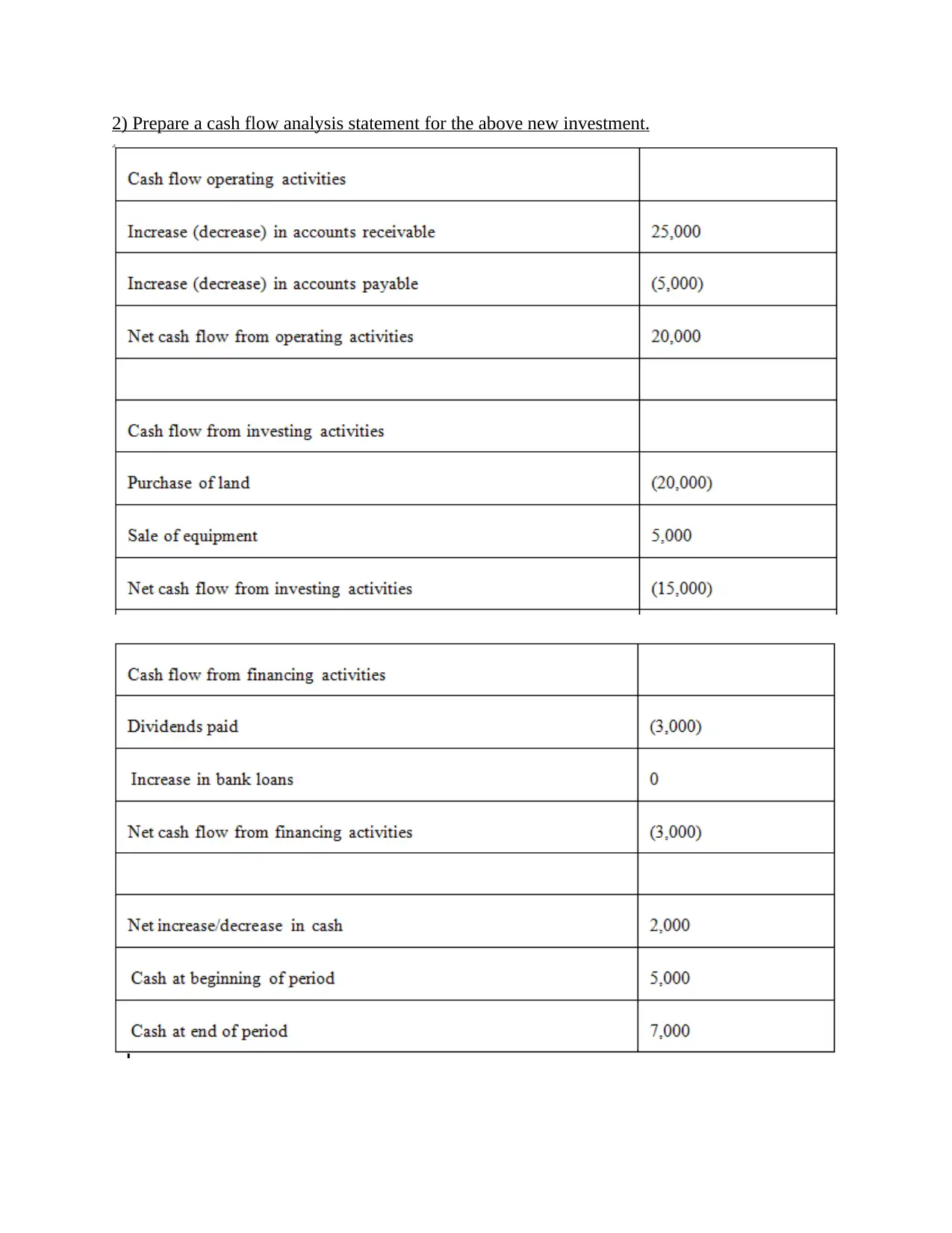
2) Prepare a cash flow analysis statement for the above new investment.
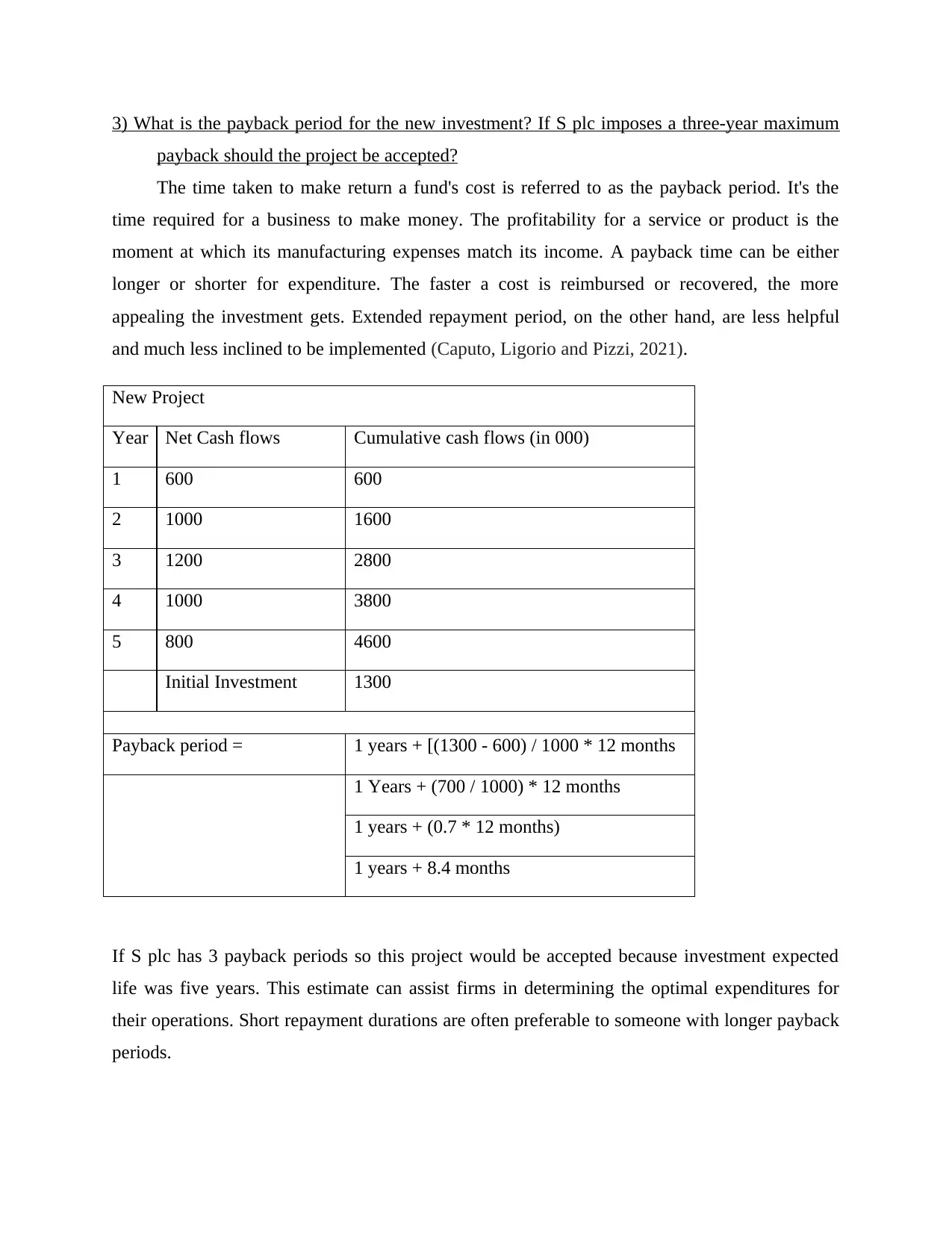
3) What is the payback period for the new investment? If S plc imposes a three-year maximum
payback should the project be accepted?
The time taken to make return a fund's cost is referred to as the payback period. It's the
time required for a business to make money. The profitability for a service or product is the
moment at which its manufacturing expenses match its income. A payback time can be either
longer or shorter for expenditure. The faster a cost is reimbursed or recovered, the more
appealing the investment gets. Extended repayment period, on the other hand, are less helpful
and much less inclined to be implemented (Caputo, Ligorio and Pizzi, 2021).
New Project
Year Net Cash flows Cumulative cash flows (in 000)
1 600 600
2 1000 1600
3 1200 2800
4 1000 3800
5 800 4600
Initial Investment 1300
Payback period = 1 years + [(1300 - 600) / 1000 * 12 months
1 Years + (700 / 1000) * 12 months
1 years + (0.7 * 12 months)
1 years + 8.4 months
If S plc has 3 payback periods so this project would be accepted because investment expected
life was five years. This estimate can assist firms in determining the optimal expenditures for
their operations. Short repayment durations are often preferable to someone with longer payback
periods.
payback should the project be accepted?
The time taken to make return a fund's cost is referred to as the payback period. It's the
time required for a business to make money. The profitability for a service or product is the
moment at which its manufacturing expenses match its income. A payback time can be either
longer or shorter for expenditure. The faster a cost is reimbursed or recovered, the more
appealing the investment gets. Extended repayment period, on the other hand, are less helpful
and much less inclined to be implemented (Caputo, Ligorio and Pizzi, 2021).
New Project
Year Net Cash flows Cumulative cash flows (in 000)
1 600 600
2 1000 1600
3 1200 2800
4 1000 3800
5 800 4600
Initial Investment 1300
Payback period = 1 years + [(1300 - 600) / 1000 * 12 months
1 Years + (700 / 1000) * 12 months
1 years + (0.7 * 12 months)
1 years + 8.4 months
If S plc has 3 payback periods so this project would be accepted because investment expected
life was five years. This estimate can assist firms in determining the optimal expenditures for
their operations. Short repayment durations are often preferable to someone with longer payback
periods.
⊘ This is a preview!⊘
Do you want full access?
Subscribe today to unlock all pages.

Trusted by 1+ million students worldwide
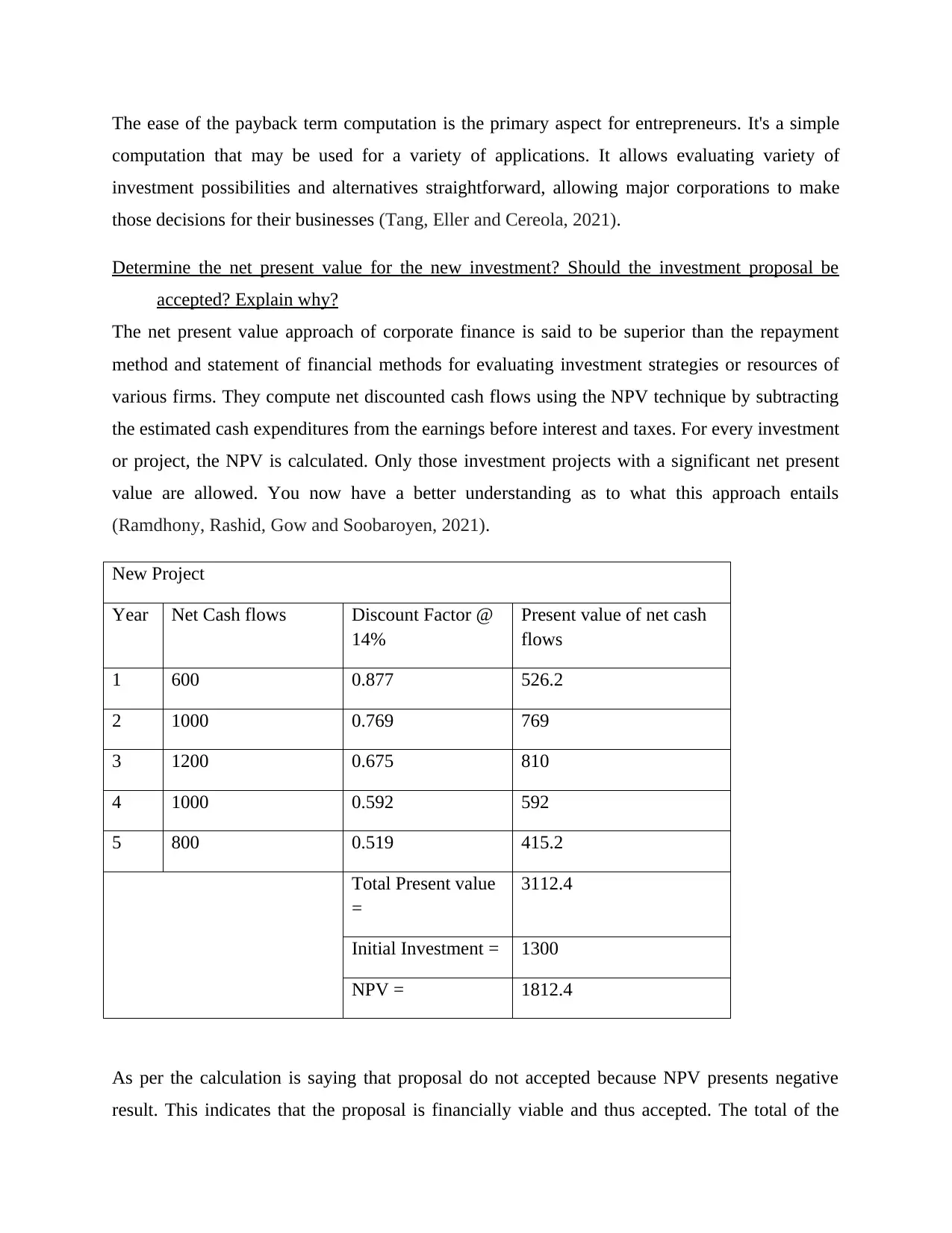
The ease of the payback term computation is the primary aspect for entrepreneurs. It's a simple
computation that may be used for a variety of applications. It allows evaluating variety of
investment possibilities and alternatives straightforward, allowing major corporations to make
those decisions for their businesses (Tang, Eller and Cereola, 2021).
Determine the net present value for the new investment? Should the investment proposal be
accepted? Explain why?
The net present value approach of corporate finance is said to be superior than the repayment
method and statement of financial methods for evaluating investment strategies or resources of
various firms. They compute net discounted cash flows using the NPV technique by subtracting
the estimated cash expenditures from the earnings before interest and taxes. For every investment
or project, the NPV is calculated. Only those investment projects with a significant net present
value are allowed. You now have a better understanding as to what this approach entails
(Ramdhony, Rashid, Gow and Soobaroyen, 2021).
New Project
Year Net Cash flows Discount Factor @
14%
Present value of net cash
flows
1 600 0.877 526.2
2 1000 0.769 769
3 1200 0.675 810
4 1000 0.592 592
5 800 0.519 415.2
Total Present value
=
3112.4
Initial Investment = 1300
NPV = 1812.4
As per the calculation is saying that proposal do not accepted because NPV presents negative
result. This indicates that the proposal is financially viable and thus accepted. The total of the
computation that may be used for a variety of applications. It allows evaluating variety of
investment possibilities and alternatives straightforward, allowing major corporations to make
those decisions for their businesses (Tang, Eller and Cereola, 2021).
Determine the net present value for the new investment? Should the investment proposal be
accepted? Explain why?
The net present value approach of corporate finance is said to be superior than the repayment
method and statement of financial methods for evaluating investment strategies or resources of
various firms. They compute net discounted cash flows using the NPV technique by subtracting
the estimated cash expenditures from the earnings before interest and taxes. For every investment
or project, the NPV is calculated. Only those investment projects with a significant net present
value are allowed. You now have a better understanding as to what this approach entails
(Ramdhony, Rashid, Gow and Soobaroyen, 2021).
New Project
Year Net Cash flows Discount Factor @
14%
Present value of net cash
flows
1 600 0.877 526.2
2 1000 0.769 769
3 1200 0.675 810
4 1000 0.592 592
5 800 0.519 415.2
Total Present value
=
3112.4
Initial Investment = 1300
NPV = 1812.4
As per the calculation is saying that proposal do not accepted because NPV presents negative
result. This indicates that the proposal is financially viable and thus accepted. The total of the
Paraphrase This Document
Need a fresh take? Get an instant paraphrase of this document with our AI Paraphraser
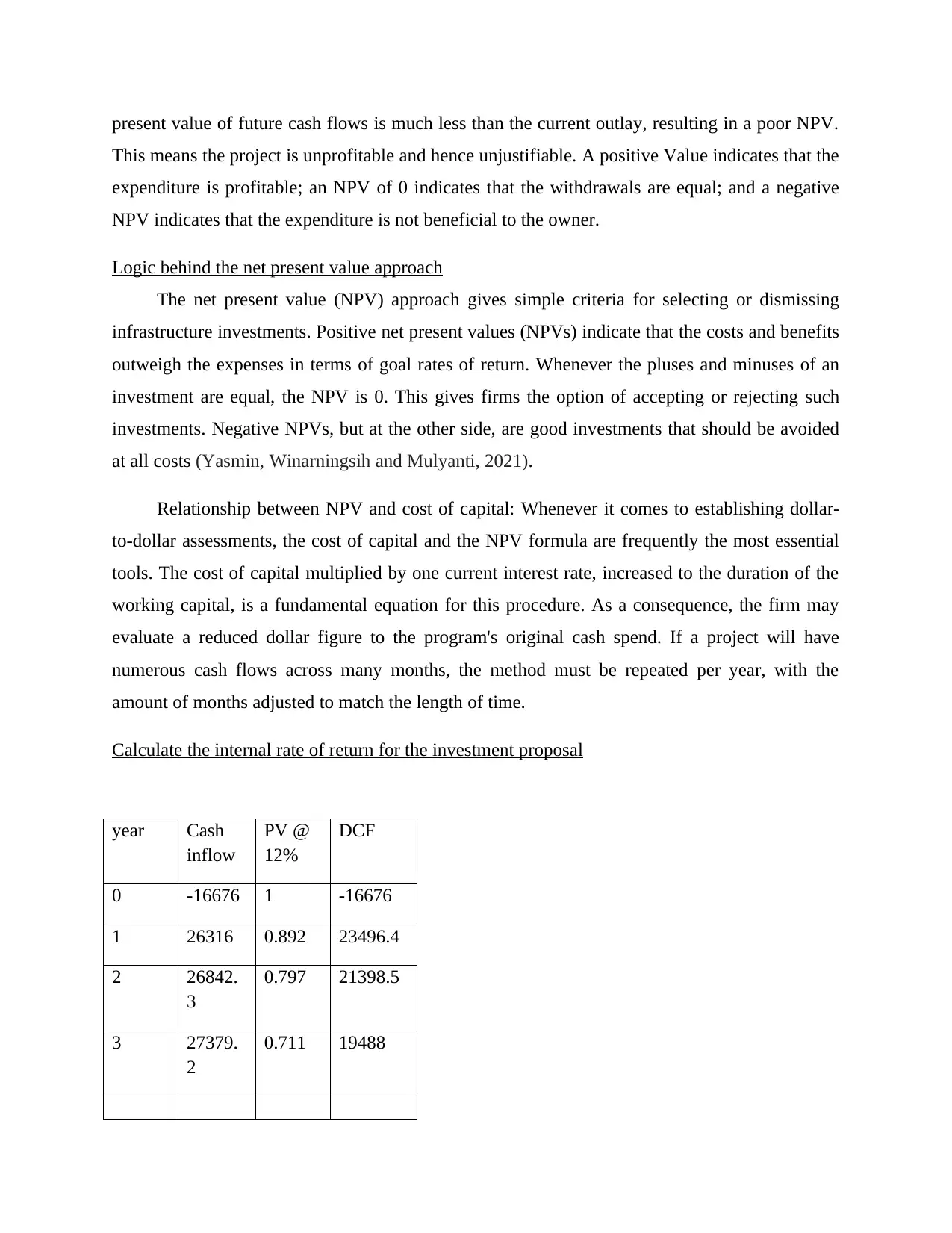
present value of future cash flows is much less than the current outlay, resulting in a poor NPV.
This means the project is unprofitable and hence unjustifiable. A positive Value indicates that the
expenditure is profitable; an NPV of 0 indicates that the withdrawals are equal; and a negative
NPV indicates that the expenditure is not beneficial to the owner.
Logic behind the net present value approach
The net present value (NPV) approach gives simple criteria for selecting or dismissing
infrastructure investments. Positive net present values (NPVs) indicate that the costs and benefits
outweigh the expenses in terms of goal rates of return. Whenever the pluses and minuses of an
investment are equal, the NPV is 0. This gives firms the option of accepting or rejecting such
investments. Negative NPVs, but at the other side, are good investments that should be avoided
at all costs (Yasmin, Winarningsih and Mulyanti, 2021).
Relationship between NPV and cost of capital: Whenever it comes to establishing dollar-
to-dollar assessments, the cost of capital and the NPV formula are frequently the most essential
tools. The cost of capital multiplied by one current interest rate, increased to the duration of the
working capital, is a fundamental equation for this procedure. As a consequence, the firm may
evaluate a reduced dollar figure to the program's original cash spend. If a project will have
numerous cash flows across many months, the method must be repeated per year, with the
amount of months adjusted to match the length of time.
Calculate the internal rate of return for the investment proposal
year Cash
inflow
PV @
12%
DCF
0 -16676 1 -16676
1 26316 0.892 23496.4
2 26842.
3
0.797 21398.5
3 27379.
2
0.711 19488
This means the project is unprofitable and hence unjustifiable. A positive Value indicates that the
expenditure is profitable; an NPV of 0 indicates that the withdrawals are equal; and a negative
NPV indicates that the expenditure is not beneficial to the owner.
Logic behind the net present value approach
The net present value (NPV) approach gives simple criteria for selecting or dismissing
infrastructure investments. Positive net present values (NPVs) indicate that the costs and benefits
outweigh the expenses in terms of goal rates of return. Whenever the pluses and minuses of an
investment are equal, the NPV is 0. This gives firms the option of accepting or rejecting such
investments. Negative NPVs, but at the other side, are good investments that should be avoided
at all costs (Yasmin, Winarningsih and Mulyanti, 2021).
Relationship between NPV and cost of capital: Whenever it comes to establishing dollar-
to-dollar assessments, the cost of capital and the NPV formula are frequently the most essential
tools. The cost of capital multiplied by one current interest rate, increased to the duration of the
working capital, is a fundamental equation for this procedure. As a consequence, the firm may
evaluate a reduced dollar figure to the program's original cash spend. If a project will have
numerous cash flows across many months, the method must be repeated per year, with the
amount of months adjusted to match the length of time.
Calculate the internal rate of return for the investment proposal
year Cash
inflow
PV @
12%
DCF
0 -16676 1 -16676
1 26316 0.892 23496.4
2 26842.
3
0.797 21398.5
3 27379.
2
0.711 19488
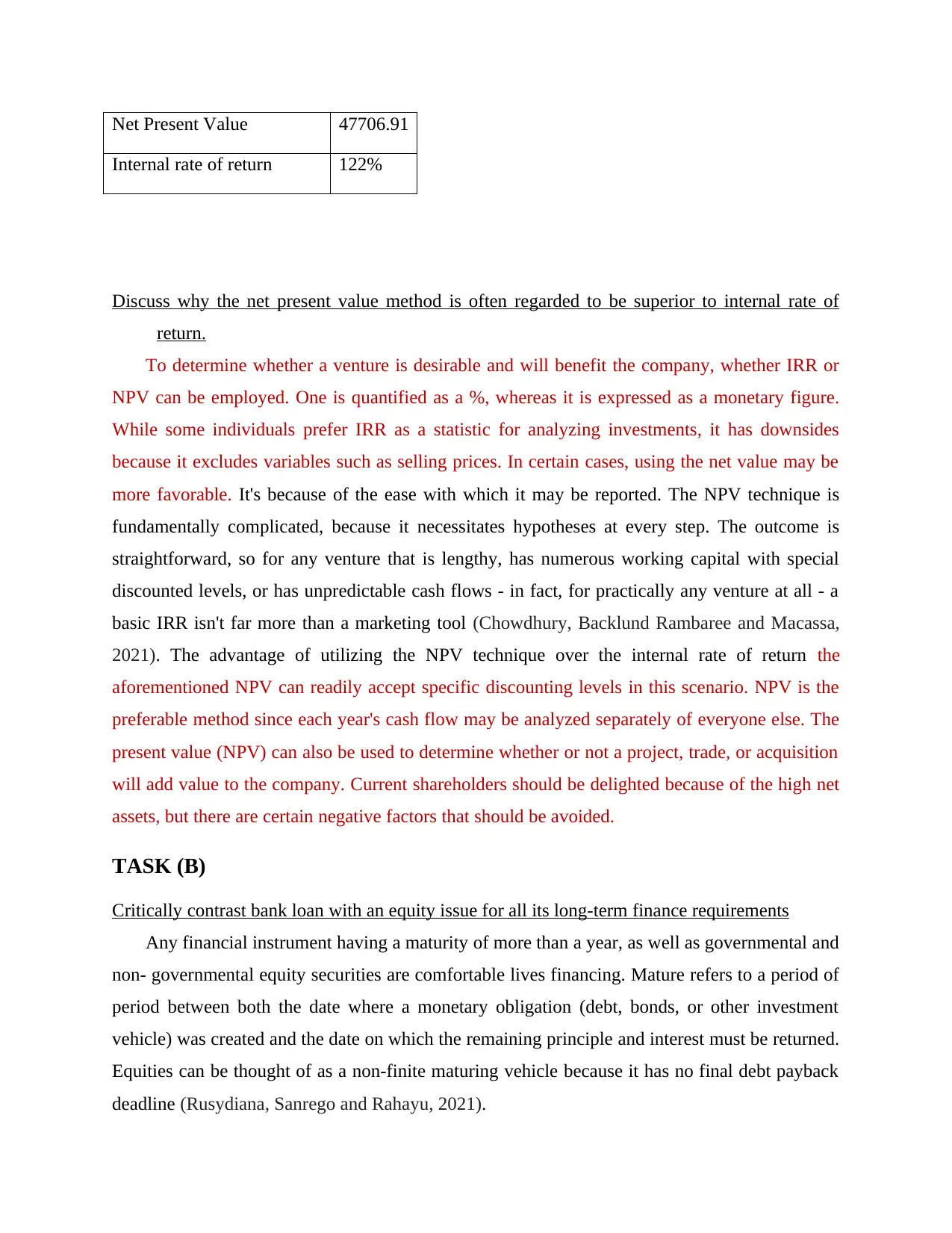
Net Present Value 47706.91
Internal rate of return 122%
Discuss why the net present value method is often regarded to be superior to internal rate of
return.
To determine whether a venture is desirable and will benefit the company, whether IRR or
NPV can be employed. One is quantified as a %, whereas it is expressed as a monetary figure.
While some individuals prefer IRR as a statistic for analyzing investments, it has downsides
because it excludes variables such as selling prices. In certain cases, using the net value may be
more favorable. It's because of the ease with which it may be reported. The NPV technique is
fundamentally complicated, because it necessitates hypotheses at every step. The outcome is
straightforward, so for any venture that is lengthy, has numerous working capital with special
discounted levels, or has unpredictable cash flows - in fact, for practically any venture at all - a
basic IRR isn't far more than a marketing tool (Chowdhury, Backlund Rambaree and Macassa,
2021). The advantage of utilizing the NPV technique over the internal rate of return the
aforementioned NPV can readily accept specific discounting levels in this scenario. NPV is the
preferable method since each year's cash flow may be analyzed separately of everyone else. The
present value (NPV) can also be used to determine whether or not a project, trade, or acquisition
will add value to the company. Current shareholders should be delighted because of the high net
assets, but there are certain negative factors that should be avoided.
TASK (B)
Critically contrast bank loan with an equity issue for all its long-term finance requirements
Any financial instrument having a maturity of more than a year, as well as governmental and
non- governmental equity securities are comfortable lives financing. Mature refers to a period of
period between both the date where a monetary obligation (debt, bonds, or other investment
vehicle) was created and the date on which the remaining principle and interest must be returned.
Equities can be thought of as a non-finite maturing vehicle because it has no final debt payback
deadline (Rusydiana, Sanrego and Rahayu, 2021).
Internal rate of return 122%
Discuss why the net present value method is often regarded to be superior to internal rate of
return.
To determine whether a venture is desirable and will benefit the company, whether IRR or
NPV can be employed. One is quantified as a %, whereas it is expressed as a monetary figure.
While some individuals prefer IRR as a statistic for analyzing investments, it has downsides
because it excludes variables such as selling prices. In certain cases, using the net value may be
more favorable. It's because of the ease with which it may be reported. The NPV technique is
fundamentally complicated, because it necessitates hypotheses at every step. The outcome is
straightforward, so for any venture that is lengthy, has numerous working capital with special
discounted levels, or has unpredictable cash flows - in fact, for practically any venture at all - a
basic IRR isn't far more than a marketing tool (Chowdhury, Backlund Rambaree and Macassa,
2021). The advantage of utilizing the NPV technique over the internal rate of return the
aforementioned NPV can readily accept specific discounting levels in this scenario. NPV is the
preferable method since each year's cash flow may be analyzed separately of everyone else. The
present value (NPV) can also be used to determine whether or not a project, trade, or acquisition
will add value to the company. Current shareholders should be delighted because of the high net
assets, but there are certain negative factors that should be avoided.
TASK (B)
Critically contrast bank loan with an equity issue for all its long-term finance requirements
Any financial instrument having a maturity of more than a year, as well as governmental and
non- governmental equity securities are comfortable lives financing. Mature refers to a period of
period between both the date where a monetary obligation (debt, bonds, or other investment
vehicle) was created and the date on which the remaining principle and interest must be returned.
Equities can be thought of as a non-finite maturing vehicle because it has no final debt payback
deadline (Rusydiana, Sanrego and Rahayu, 2021).
⊘ This is a preview!⊘
Do you want full access?
Subscribe today to unlock all pages.

Trusted by 1+ million students worldwide
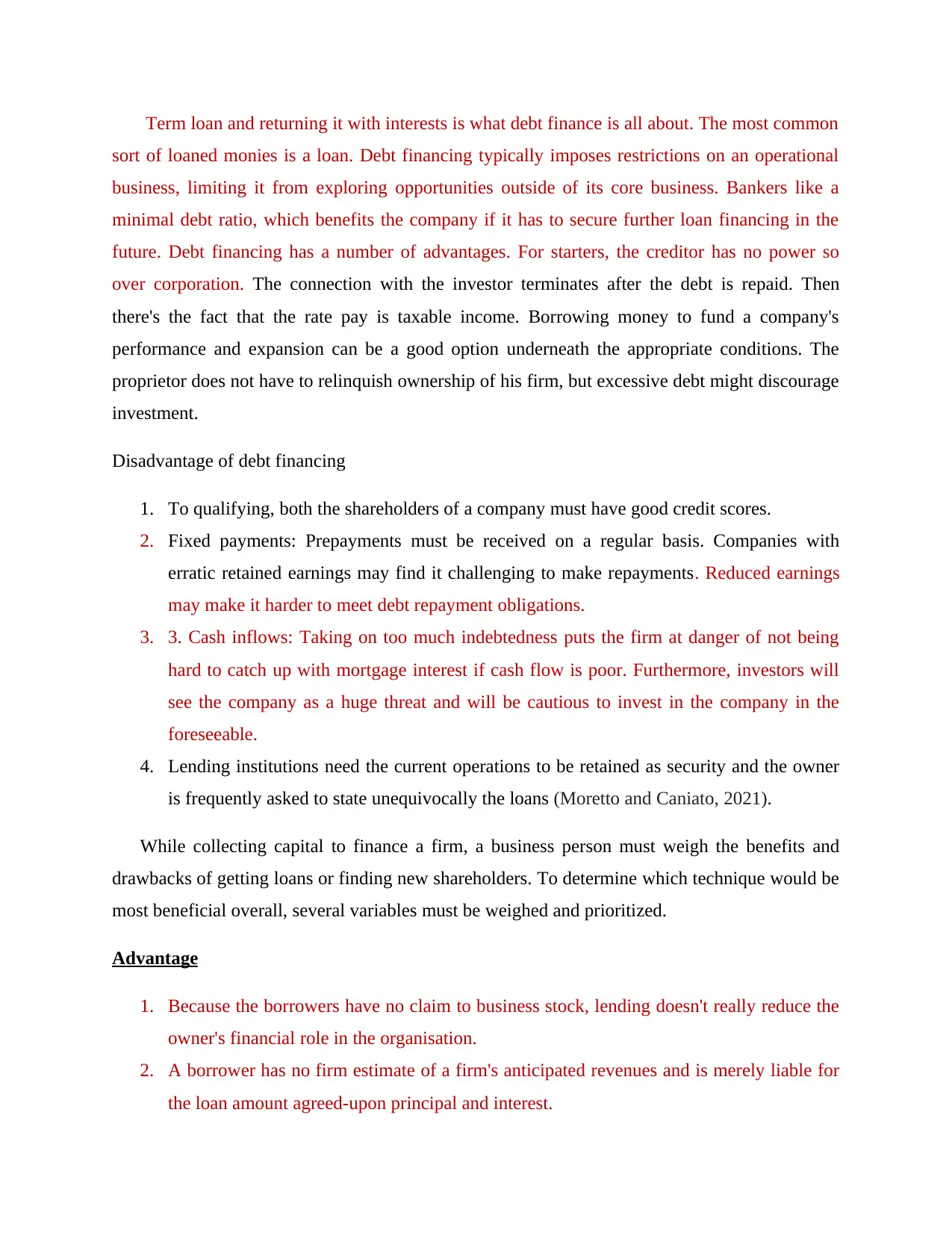
Term loan and returning it with interests is what debt finance is all about. The most common
sort of loaned monies is a loan. Debt financing typically imposes restrictions on an operational
business, limiting it from exploring opportunities outside of its core business. Bankers like a
minimal debt ratio, which benefits the company if it has to secure further loan financing in the
future. Debt financing has a number of advantages. For starters, the creditor has no power so
over corporation. The connection with the investor terminates after the debt is repaid. Then
there's the fact that the rate pay is taxable income. Borrowing money to fund a company's
performance and expansion can be a good option underneath the appropriate conditions. The
proprietor does not have to relinquish ownership of his firm, but excessive debt might discourage
investment.
Disadvantage of debt financing
1. To qualifying, both the shareholders of a company must have good credit scores.
2. Fixed payments: Prepayments must be received on a regular basis. Companies with
erratic retained earnings may find it challenging to make repayments. Reduced earnings
may make it harder to meet debt repayment obligations.
3. 3. Cash inflows: Taking on too much indebtedness puts the firm at danger of not being
hard to catch up with mortgage interest if cash flow is poor. Furthermore, investors will
see the company as a huge threat and will be cautious to invest in the company in the
foreseeable.
4. Lending institutions need the current operations to be retained as security and the owner
is frequently asked to state unequivocally the loans (Moretto and Caniato, 2021).
While collecting capital to finance a firm, a business person must weigh the benefits and
drawbacks of getting loans or finding new shareholders. To determine which technique would be
most beneficial overall, several variables must be weighed and prioritized.
Advantage
1. Because the borrowers have no claim to business stock, lending doesn't really reduce the
owner's financial role in the organisation.
2. A borrower has no firm estimate of a firm's anticipated revenues and is merely liable for
the loan amount agreed-upon principal and interest.
sort of loaned monies is a loan. Debt financing typically imposes restrictions on an operational
business, limiting it from exploring opportunities outside of its core business. Bankers like a
minimal debt ratio, which benefits the company if it has to secure further loan financing in the
future. Debt financing has a number of advantages. For starters, the creditor has no power so
over corporation. The connection with the investor terminates after the debt is repaid. Then
there's the fact that the rate pay is taxable income. Borrowing money to fund a company's
performance and expansion can be a good option underneath the appropriate conditions. The
proprietor does not have to relinquish ownership of his firm, but excessive debt might discourage
investment.
Disadvantage of debt financing
1. To qualifying, both the shareholders of a company must have good credit scores.
2. Fixed payments: Prepayments must be received on a regular basis. Companies with
erratic retained earnings may find it challenging to make repayments. Reduced earnings
may make it harder to meet debt repayment obligations.
3. 3. Cash inflows: Taking on too much indebtedness puts the firm at danger of not being
hard to catch up with mortgage interest if cash flow is poor. Furthermore, investors will
see the company as a huge threat and will be cautious to invest in the company in the
foreseeable.
4. Lending institutions need the current operations to be retained as security and the owner
is frequently asked to state unequivocally the loans (Moretto and Caniato, 2021).
While collecting capital to finance a firm, a business person must weigh the benefits and
drawbacks of getting loans or finding new shareholders. To determine which technique would be
most beneficial overall, several variables must be weighed and prioritized.
Advantage
1. Because the borrowers have no claim to business stock, lending doesn't really reduce the
owner's financial role in the organisation.
2. A borrower has no firm estimate of a firm's anticipated revenues and is merely liable for
the loan amount agreed-upon principal and interest.
Paraphrase This Document
Need a fresh take? Get an instant paraphrase of this document with our AI Paraphraser
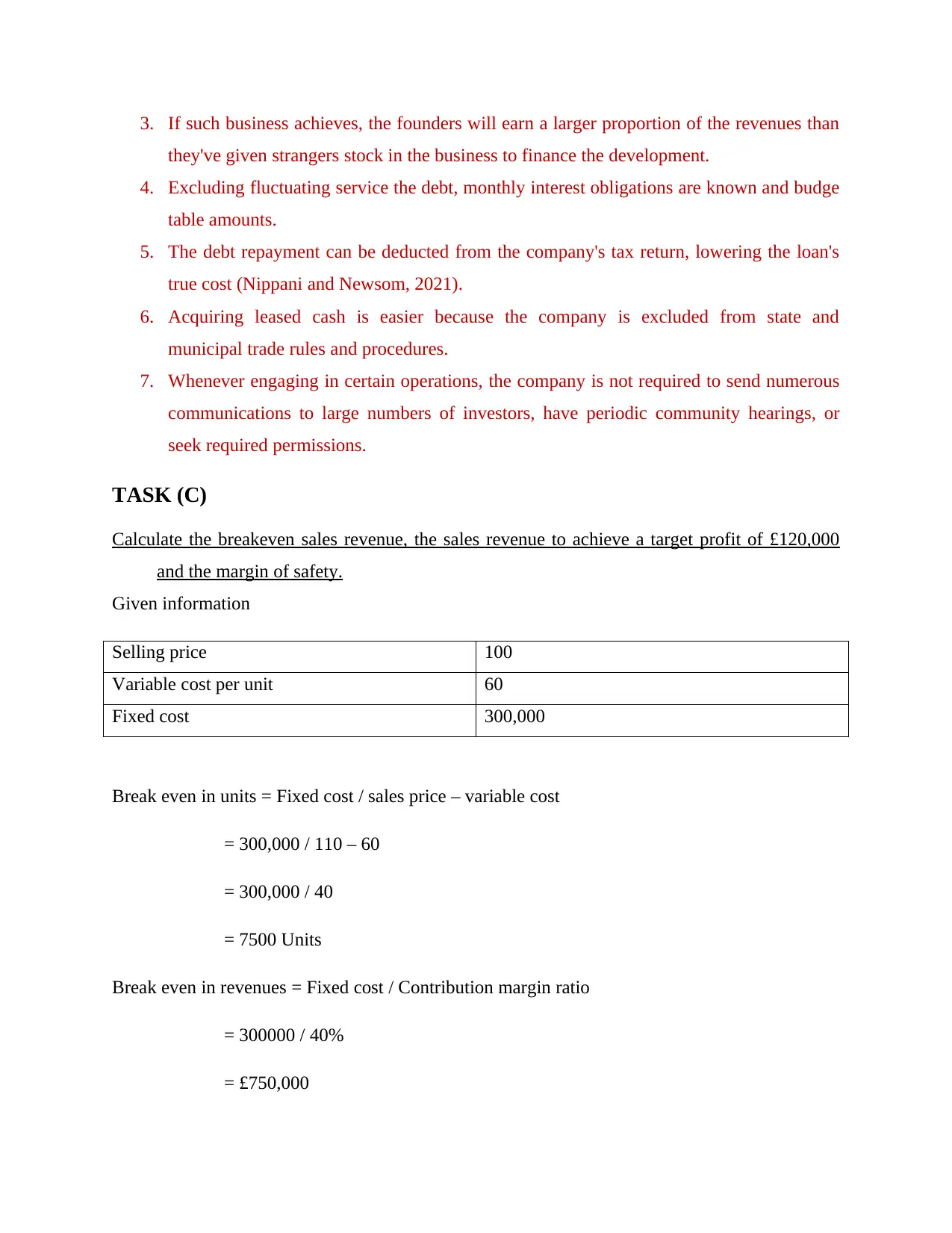
3. If such business achieves, the founders will earn a larger proportion of the revenues than
they've given strangers stock in the business to finance the development.
4. Excluding fluctuating service the debt, monthly interest obligations are known and budge
table amounts.
5. The debt repayment can be deducted from the company's tax return, lowering the loan's
true cost (Nippani and Newsom, 2021).
6. Acquiring leased cash is easier because the company is excluded from state and
municipal trade rules and procedures.
7. Whenever engaging in certain operations, the company is not required to send numerous
communications to large numbers of investors, have periodic community hearings, or
seek required permissions.
TASK (C)
Calculate the breakeven sales revenue, the sales revenue to achieve a target profit of £120,000
and the margin of safety.
Given information
Selling price 100
Variable cost per unit 60
Fixed cost 300,000
Break even in units = Fixed cost / sales price – variable cost
= 300,000 / 110 – 60
= 300,000 / 40
= 7500 Units
Break even in revenues = Fixed cost / Contribution margin ratio
= 300000 / 40%
= £750,000
they've given strangers stock in the business to finance the development.
4. Excluding fluctuating service the debt, monthly interest obligations are known and budge
table amounts.
5. The debt repayment can be deducted from the company's tax return, lowering the loan's
true cost (Nippani and Newsom, 2021).
6. Acquiring leased cash is easier because the company is excluded from state and
municipal trade rules and procedures.
7. Whenever engaging in certain operations, the company is not required to send numerous
communications to large numbers of investors, have periodic community hearings, or
seek required permissions.
TASK (C)
Calculate the breakeven sales revenue, the sales revenue to achieve a target profit of £120,000
and the margin of safety.
Given information
Selling price 100
Variable cost per unit 60
Fixed cost 300,000
Break even in units = Fixed cost / sales price – variable cost
= 300,000 / 110 – 60
= 300,000 / 40
= 7500 Units
Break even in revenues = Fixed cost / Contribution margin ratio
= 300000 / 40%
= £750,000
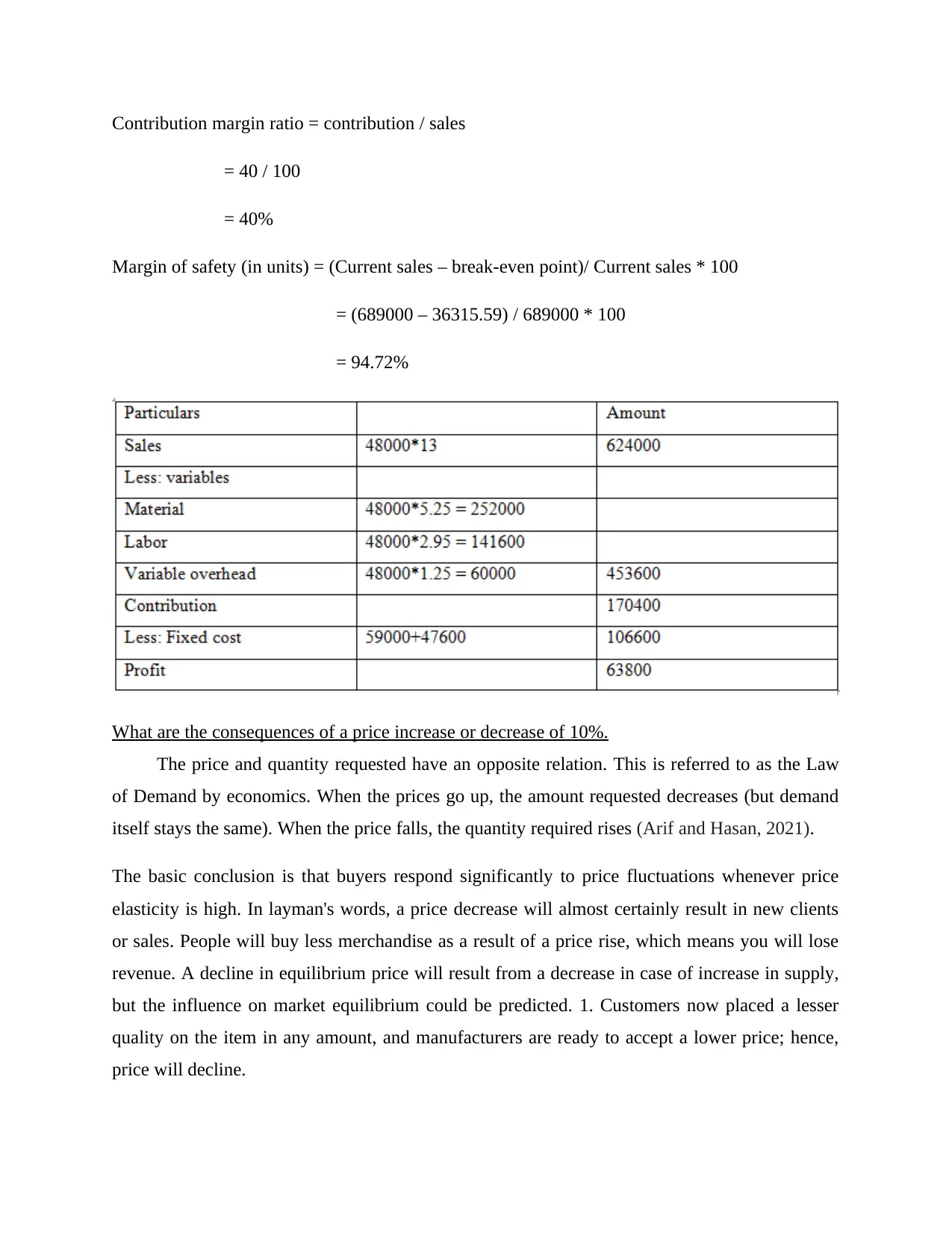
Contribution margin ratio = contribution / sales
= 40 / 100
= 40%
Margin of safety (in units) = (Current sales – break-even point)/ Current sales * 100
= (689000 – 36315.59) / 689000 * 100
= 94.72%
What are the consequences of a price increase or decrease of 10%.
The price and quantity requested have an opposite relation. This is referred to as the Law
of Demand by economics. When the prices go up, the amount requested decreases (but demand
itself stays the same). When the price falls, the quantity required rises (Arif and Hasan, 2021).
The basic conclusion is that buyers respond significantly to price fluctuations whenever price
elasticity is high. In layman's words, a price decrease will almost certainly result in new clients
or sales. People will buy less merchandise as a result of a price rise, which means you will lose
revenue. A decline in equilibrium price will result from a decrease in case of increase in supply,
but the influence on market equilibrium could be predicted. 1. Customers now placed a lesser
quality on the item in any amount, and manufacturers are ready to accept a lower price; hence,
price will decline.
= 40 / 100
= 40%
Margin of safety (in units) = (Current sales – break-even point)/ Current sales * 100
= (689000 – 36315.59) / 689000 * 100
= 94.72%
What are the consequences of a price increase or decrease of 10%.
The price and quantity requested have an opposite relation. This is referred to as the Law
of Demand by economics. When the prices go up, the amount requested decreases (but demand
itself stays the same). When the price falls, the quantity required rises (Arif and Hasan, 2021).
The basic conclusion is that buyers respond significantly to price fluctuations whenever price
elasticity is high. In layman's words, a price decrease will almost certainly result in new clients
or sales. People will buy less merchandise as a result of a price rise, which means you will lose
revenue. A decline in equilibrium price will result from a decrease in case of increase in supply,
but the influence on market equilibrium could be predicted. 1. Customers now placed a lesser
quality on the item in any amount, and manufacturers are ready to accept a lower price; hence,
price will decline.
⊘ This is a preview!⊘
Do you want full access?
Subscribe today to unlock all pages.

Trusted by 1+ million students worldwide
1 out of 17
Related Documents
Your All-in-One AI-Powered Toolkit for Academic Success.
+13062052269
info@desklib.com
Available 24*7 on WhatsApp / Email
![[object Object]](/_next/static/media/star-bottom.7253800d.svg)
Unlock your academic potential
Copyright © 2020–2025 A2Z Services. All Rights Reserved. Developed and managed by ZUCOL.





